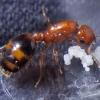- Formiculture.com
- Forums
- Gallery
- Members
- Member Map
- Chat

NPLT Ant Journal
Started By
NPLT
, May 9 2021 9:05 AM
myrmica sp. journal camponotus fallax osmia rufa manica rubida cthonolasius formica rufibarbis
101 replies to this topic
#41
 Offline
-
Posted July 2 2021 - 3:38 PM
Offline
-
Posted July 2 2021 - 3:38 PM
Nice work!
- yaboiseth and NPLT like this
"The ants are a people not strong, yet they prepare their meat in the summer." Prov. 30:25
Keep ordinary ants in extraordinary ways.
Keep ordinary ants in extraordinary ways.
#42
 Offline
-
Posted July 2 2021 - 7:42 PM
Offline
-
Posted July 2 2021 - 7:42 PM
Great job! Pretty interesting journal ![]() I like reading about species in other countries.
I like reading about species in other countries.
- NPLT likes this
#43
 Offline
-
Posted July 2 2021 - 7:44 PM
Offline
-
Posted July 2 2021 - 7:44 PM
And don't say that no one cares about this journal as it has 1000+ views ![]()
Edited by yaboiseth, July 2 2021 - 7:44 PM.
- NPLT likes this
#44
 Offline
-
Posted July 2 2021 - 7:55 PM
Offline
-
Posted July 2 2021 - 7:55 PM
Nice!
You should be able to distinguish the fallax from vagus by size, I imagine, being subgenus Myrmentoma, fallax would be considerably smaller than vagus.
- yaboiseth, Antkeeper01 and NPLT like this
Hi there! I went on a 6 month or so hiatus, in part due, and in part cause of the death of my colonies.
However, I went back to the Sierras, and restarted my collection, which is now as follows:
Aphaenogaster uinta, Camponotus vicinus, Camponotus modoc, Formica cf. aserva, Formica cf. micropthalma, Formica cf. manni, Formica subpolita, Formica cf. subaenescens, Lasius americanus, Manica invidia, Pogonomyrmex salinus, Pogonomyrmex sp. 1, Solenopsis validiuscula, & Solenopsis sp. 3 (new Sierra variant).
#45
 Offline
-
Posted July 3 2021 - 2:00 AM
Offline
-
Posted July 3 2021 - 2:00 AM
And don't say that no one cares about this journal as it has 1000+ views
How do I check the views?
Nice!
You should be able to distinguish the fallax from vagus by size, I imagine, being subgenus Myrmentoma, fallax would be considerably smaller than vagus.
Hm, I see, I'll try to get measurements when I come back from vacations.
#46
 Offline
-
Posted July 3 2021 - 2:34 AM
Offline
-
Posted July 3 2021 - 2:34 AM
Go in the Ant Keeping Journals sub forum. To the side, you should see the number of views. You can’t see it in mobile, only PC. Nice work, my friend. Keep at it.How do I check the views?
And don't say that no one cares about this journal as it has 1000+ viewsHm, I see, I'll try to get measurements when I come back from vacations.Nice!
You should be able to distinguish the fallax from vagus by size, I imagine, being subgenus Myrmentoma, fallax would be considerably smaller than vagus.
- NPLT likes this
"The ants are a people not strong, yet they prepare their meat in the summer." Prov. 30:25
Keep ordinary ants in extraordinary ways.
Keep ordinary ants in extraordinary ways.
#47
 Offline
-
Posted July 3 2021 - 3:59 AM
Offline
-
Posted July 3 2021 - 3:59 AM
Go in the Ant Keeping Journals sub forum. To the side, you should see the number of views. You can’t see it in mobile, only PC. Nice work, my friend. Keep at it.
How do I check the views?And don't say that no one cares about this journal as it has 1000+ views
Hm, I see, I'll try to get measurements when I come back from vacations.Nice!
You should be able to distinguish the fallax from vagus by size, I imagine, being subgenus Myrmentoma, fallax would be considerably smaller than vagus.
Oh! Alright.
Well, thanks for the 1k views I was unaware of, the whole time I was thinking 6 people at most were reading it.
- Antkeeper01 and antsandmore like this
#48
 Offline
-
Posted July 3 2021 - 4:37 AM
Offline
-
Posted July 3 2021 - 4:37 AM
I told you. Most people are humble enough not to comment about species they don’t keep, doesn’t mean they aren’t reading.
- Antkeeper01 and NPLT like this
"The ants are a people not strong, yet they prepare their meat in the summer." Prov. 30:25
Keep ordinary ants in extraordinary ways.
Keep ordinary ants in extraordinary ways.
#49
 Offline
-
Posted July 18 2021 - 8:16 AM
Offline
-
Posted July 18 2021 - 8:16 AM
I'm back!
Will make a full-fledged update next week but I do have a mini-date.
CAUGHT A FORMICA RUFIBARBIS QUEEN!!!!!! Literally one of my two dream species! ![]()
- ANTdrew, Antkeeper01 and DaAnt like this
#50
 Offline
-
Posted July 18 2021 - 8:25 AM
Offline
-
Posted July 18 2021 - 8:25 AM
Nice!
- Antkeeper01 and NPLT like this
"The ants are a people not strong, yet they prepare their meat in the summer." Prov. 30:25
Keep ordinary ants in extraordinary ways.
Keep ordinary ants in extraordinary ways.
#51
 Offline
-
Posted July 22 2021 - 11:32 AM
Offline
-
Posted July 22 2021 - 11:32 AM
Update 12: 22/07/21
The update I promised. Only included the good photos
Myrmica sp.
Size: 1 queen, ~7 workers, a batch of brood.
I am very happy to see a fresh batch of brood, Gift is seemingly working double time to produce a second generation of workers before hibernation, also, today is the first time I saw them eat, and there were more of them than anticipated, they're camouflaging really well with their substrate, which is both worrying, and kinda cool. Their test tube is really dirty and I'm wondering if I should attach a second tube.
Camponotus fallax
Size: 1 queen, 2 workers, 4 pupae, 2 larvae, many eggs
Second worker eclosed, there are also pupae waiting and a fresh batch of eggs, Gerd's gaster has gotten larger, which is good, the workers must be real busy feeding her, lastly, before I went on vacations I didn't notice that their water supply wasn't shielded from the sun so it kinda started evaporating, it has been since fixed, but I will be attaching a second tube soon.
Manica rubida
Size: 1 queen, brood in all stages
She has pupae after about a month and a half, after I received her with very small larvae, once again proving just how long their founding period is considering they fly as early as March.
Lasius (chtonolasius) sp.
Size: 1 queen, hundreds of host workers, brood?
The queen has so far refused to move, workers are still hanging around in the outworld ( and I really need to find a solution for this because they panic whenever I try to clean up ) brood is still probably there, there was one escape today and I can't find her :c.
Formica c.f rufibarbis
Size: 1 queen, batch of eggs
Our new arrival, hasn't come up with a name for her yet, but she is a strong one, already having brood a day after her capture, and surviving a 4 hour car drive with her and all the brood intact, she's hopefully here to stay, and I will finally utilize that THA Nest when she has her first generation of workers
Closing Thougths:
I'm glad everyone survived my absence and being fed by someone else, also I've been writing a non-ant related book the last couple of days.
So, bye, and it would be really nice of you if you'd comment something.
- yaboiseth and Antkeeper01 like this
#52
 Offline
-
Posted July 22 2021 - 11:35 AM
Offline
-
Posted July 22 2021 - 11:35 AM
Escapee has been found, repeat, escapee found!
- Antkeeper01 likes this
#53
 Offline
-
Posted July 23 2021 - 3:13 AM
Offline
-
Posted July 23 2021 - 3:13 AM
Keep up the good work! Keep the ants really warm and feed them like a Slavic grandmother, and they will thrive.
- smares, Antkeeper01 and NPLT like this
"The ants are a people not strong, yet they prepare their meat in the summer." Prov. 30:25
Keep ordinary ants in extraordinary ways.
Keep ordinary ants in extraordinary ways.
#55
 Offline
-
Posted July 28 2021 - 3:06 PM
Offline
-
Posted July 28 2021 - 3:06 PM
Update 13: 29/07/21
Once again only included the good photos.
Myrmica sp.
Size: 1 queen, ~7 workers, at least 5 larvae, 1 pupae.
Well, I took a better photo, this time with no fancy lens and a flash, and was suprised to find one pupae, you can finally see how, well, dirty it is, the Myrmica made use of some seemingly spare cotton to make themselves more at home, at, unfortunately because of this prevented me from counting their numbers or their brood, but based on how scattered the brood is, I am hopefull they have more than 5, also, Gift decided to show herself.
Camponotus fallax
Size: 1 Queen, 3 workers, I think at least 2 pupae left, brood
Well, another worker eclosed, but because they seemingly don't like cleaning, can't really blame them, but I have no idea then, how much pupae is left to eclose, in either case, they have some brood, I think eggs and small larvae, so the colony is progressing well. I noticed that they are really photogenetic.
Manica rubida
Size: 1 queen, brood in all stages
I'm incredibly suprised by just how, well, diverse the stages of the brood are, there are eggs, larvae big and small, and of course pupae, whereas every other queen cares about just one generation at a time while founding, Devana here seems to never have stopped laying, also, good news, some pupae has started to darken, I tried to take a picture but it came out blurry.
Lasius (cthonolasius) sp.
Size: 1 queen, more than a hundred host workers, brood.
Well, the water in the tube they came to me in has run out today, hopefully when the cotton dries out, the queen finally moves, also, I noticed something funny, these ants seem to keep the queen and brood separate in different test tubes, kind of funny.
Formica cf. rufibarbis
Size: 1 queen, a pile of larvae
Well, that pile of eggs from last update? small larvae, mostly, I tried to take a pic but it came out blurry.
Closing thoughts:
In a week I'll be gone for a week and my brother will take over in feeding, well, he'll feed only once and twice the portion I usually give, will be funny as Devana will get her workers at the time, and they reportedly sting like hell.
So, bye, and it would be really nice of you if you'd comment something.
Edited by NPLT, July 28 2021 - 3:06 PM.
- Kaelwizard and Antkeeper01 like this
#56
 Offline
-
Posted July 28 2021 - 5:11 PM
Offline
-
Posted July 28 2021 - 5:11 PM
Nice brother. All seems to be going well.
- Antkeeper01 and NPLT like this
"The ants are a people not strong, yet they prepare their meat in the summer." Prov. 30:25
Keep ordinary ants in extraordinary ways.
Keep ordinary ants in extraordinary ways.
#57
 Offline
-
Posted July 29 2021 - 9:16 AM
Offline
-
Posted July 29 2021 - 9:16 AM
Well I hope he is careful with the Manica.
- Antkeeper01 and NPLT like this
#58
 Offline
-
Posted July 29 2021 - 1:20 PM
Offline
-
Posted July 29 2021 - 1:20 PM
Well I hope he is careful with the Manica.
Me too, but the outworld is small and I'll be able to replace it with a bigger one only when I return, and Manica like to rush at any disturbances.
#59
 Offline
-
Posted July 31 2021 - 2:35 AM
Offline
-
Posted July 31 2021 - 2:35 AM
I have a minidate.
Devana's first worker eclosed today. ![]()
- Antkeeper01 and antsandmore like this
#60
 Offline
-
Posted August 5 2021 - 3:58 PM
Offline
-
Posted August 5 2021 - 3:58 PM
Update 14: 06/08/21
I have good news, I have also bad news, well, just a lot of news, but first of all, I think I should mention that I keep my ants on two shelves, and these shelves will become important for this update, as Myrmica and Manica are kept on the upper shelf, while Lasius and Camponotus are kept on lower shelf ( Formica is in a separate drawer meant specifically for founding queens ).
Myrmica sp.
Size: 1 queen, ~7-8 workers, pupae and larve
Well, they're doing just fine, the brood is developing, they're doing just fine.
Camponotus fallax
Size: 1 queen, ~5 workers, 2 pupae, ~6 larvae
They had been doing just fine this week, well, due to events that will be revealed in the Lasius entry, until today. But a couple escapee Lasius workers managed to squeeze themselves through cracks in the corners of the walls of their outworld ( through which their workers either didn't want, or couldn't squeeze through. ), I have no idea what exactly happened, however based on the fact that seemingly there is no wounded or dead, it seems to me that after the workers came into contact the Camponotus workers run to their tube while the Lasius workers decided to drink old honey that was in their outworld. Because of this, I also managed to observe their defensive behavior, which, unexpedantly included two or three workers and Gerd of all ants guarding the entrance while the rest of the workers guarded the brood, thankfully nothing happened, when I noticed what was happening I discontected the outworld, just in case plugged their tube, and got the Lasius workers before putting additional tape over the cracks the Lasius workers squeezed through.
The queen guarding her realm:
The workers and brood:
Manica rubida
Size: 1 queen, 4 workers, much, much brood.
Devana is fine, the colony got their first workers while the rest of brood is growing, all is well.
Lasius (chtonolasius) sp.
Size: 1 queen, many host workers, lotta brood.
So, I messed up. In an effort to get them to move the queen and brood I disconnected their old tube, and got it into their new outworld, now came connecting their old and new outworld, I tried to tape together two separate PCV tubes, bad idea as tape folds on itself and makes cracks, and just putting on more tape does not seal these cracks, well, it does, but makes new cracks in the process thus while giving a false sense of security, is actually a ticking time bomb, add in the meantime a tube that got partially unsealed in the process of connecting and disconnecting that drew most of my attention, and so, thinking I solved everything, I go back to whatever I was doing, only to come back to feed them, and see that a good portion of the colony made a break for it, at this point I caught as many ants as I can, and thankfully caught escapees, instead of escaping, instead go for protecting the queen, then I disconnected the two outworld, plugged them, and instead of two tubes connected by tape, with a singular one, then spent a good hour catching as many escapees as I can, though I'm still fairly certain there are some left. But hey, in words on Monty Python, Look on the bright side of life. Thanks to this I finally learned they have brood either in pupal or larval stage.
Formica c.f rufibarbis
Size: 1 queen, 10(!) pupae, some larvae
So, this queen is doing good, has an outstanding number of pupae, I really can't wait until I can get her to the TarHeelAnts formicarium I bought just for this species, it seems like this queen also can't wait because this is the fastest time I saw a queen found, seemingly exactly one week for each stage ( not sure if i like this, or the four or so months for first workers that Manica rubida does more. ), and also the fact that her nanitic generation will seemingly consist of just about how many Formica workers shoud be present before releasing them to it.
Closing Thoughts:
So, today i was confronted with the reason why I don't really like colonies that have hundreds of fast, small workers, because they find the smallest opening, and squeeze through it en masse, while big ants wouldn't be able to squeeze through them, and I would be able to catch those with small numbers and slow workers before they could do any harm, while there was nearly a tragedy here with Camponotus, I can't wait until the Lasius colony gets first bio workers that are slow, docile and cute yellow.
So, bye, and it would be really nice of you if you'd comment something.
Edited by NPLT, August 5 2021 - 3:59 PM.
Also tagged with one or more of these keywords: myrmica sp., journal, camponotus fallax, osmia rufa, manica rubida, cthonolasius, formica rufibarbis
 |
Ant Keeping →
Ant Keeping Journals →
cooIboyJ's Nylanderia vividula journalStarted by cooIboyJ , Sep 6 2025 |
|

|
|
Ant Keeping →
Ant Keeping Journals →
Ants_Dakota's Camponotus sp. JournalStarted by Ants_Dakota , Jul 13 2025 |
|

|
||
Ant Keeping →
Ant Keeping Journals →
Strickys Formica JournalStarted by stricky_ants , Jun 21 2025 |
|
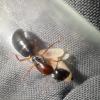
|
||
Ant Keeping →
Ant Keeping Journals →
AntTx's Camponotus sansabeanus JournalStarted by AntsTx , Jun 17 2025 |
|

|
||
Ant Keeping →
Ant Keeping Journals →
The Bark Battalion (Liometopum occidentale)Started by AntsGodzilla , Jun 3 2025 |
|

|
0 user(s) are reading this topic
0 members, 0 guests, 0 anonymous users



